Archives
-

Issue # 37 |Architectural Theories, their Performance, Quality and Effect: An Appraisal
Vol. 19 No. 2 (2025)Footprint 37 asks if it is actually possible, useful, or even necessary to appraise theories of architecture. The articles and reviews included in the issue examine the potential purpose such appraisal might have, who should do it, and when should it take place. According to the issue contributors, appraisal can consist in analysing and classifying theories accordant with their epistemological and/or pragmatic orientation. Some theories will inevitably incorporate substantial portions of tacit knowledge, either because they are deliberately shielded from criticism or because they contain practical know-how that simply hasn’t found adequate means for systematic conceptualization. Consequently, the pragmatist assumption that the quality of a theory can be measured in relation to its practical effects should also account for unforeseeable effects and generative potential. Furthermore, we are reminded that every act of appraisal is often accompanied by feelings of apprehension, and that it is always possible to alleviate those feelings by diffusing, relativising, and thus relaxing judgment.
Issue editors: Jorge Mejía Hernández and Jasper Cepl
-
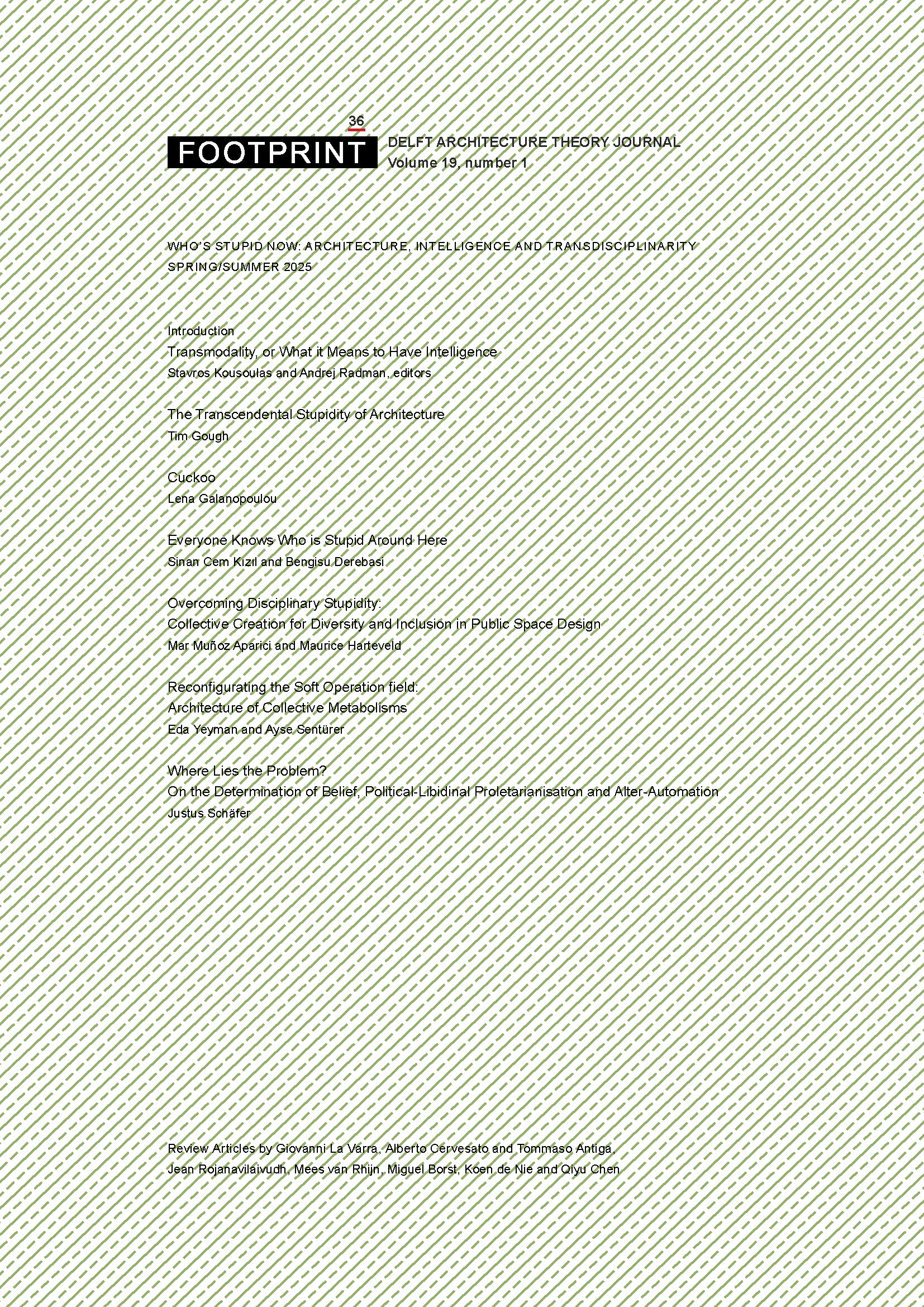
Issue # 36 | Who’s Stupid Now: Architecture, Intelligence and Transdisciplinarity
Vol. 19 No. 1 (2025)Footprint 36 explores architectural technicities that overcome poorly defined problems and reinvigorate (post)critical thinking, requiring a transdisciplinary mode of operation that breaks with the anti-intellectualist tradition of specialisation, professionalisation, and knowledge fragmentation. Rather than focusing on the essentialist question of what architectural intelligence is, Footprint 36 is dedicated to the pragmatics of how it occurs, who institutes it, and through which technicities it is archived and disseminated. This issue’s contributions examine the architectural prerequisites and ramifications of saving intelligence from the stupidity inherent in fragmented circuits of knowing and experiencing, while extrapolating on which technicities facilitate the formulation of architectural problems that address the pressing needs of our time. They do so by understanding transdisciplinarity as the coming together of diverse and heterogeneous disciplines based on their joint effort to take care of an architectural problem.
Issue editors: Stavros Kousoulas and Andrej Radman
-

Issue # 35 | Engaging Cosmotechnical Difference in Architecture and Urbanism: Cosmologies, Technologies, Worlds
Vol. 18 No. 2 (2024)Footprint 35, 'Cosmotechnical Thinking in Architecture and Urbanism,’ explores the intersection between architecture, technology and cosmology. It does so by examining the concept of ‘cosmotechnics’, a term coined by the philosopher Yuk Hui, which suggests an irreducible connection between cosmology and technology. Cosmotechnics bears directly upon a range of architectural and urban issues, including debates on preservation, decolonialism, and environmental justice. The contributions to this issue expand on the theoretical and practical intersections between cosmotechnics and architecture. They do so by foregrounding the productive tension between the local and universal dimensions of technology, within the situated contexts of different cultures. Together, they highlight the challenges and possibilities of cosmotechnics as a project of reinvention.
Issue editors: Dulmini Perera and Samuel Koh
-
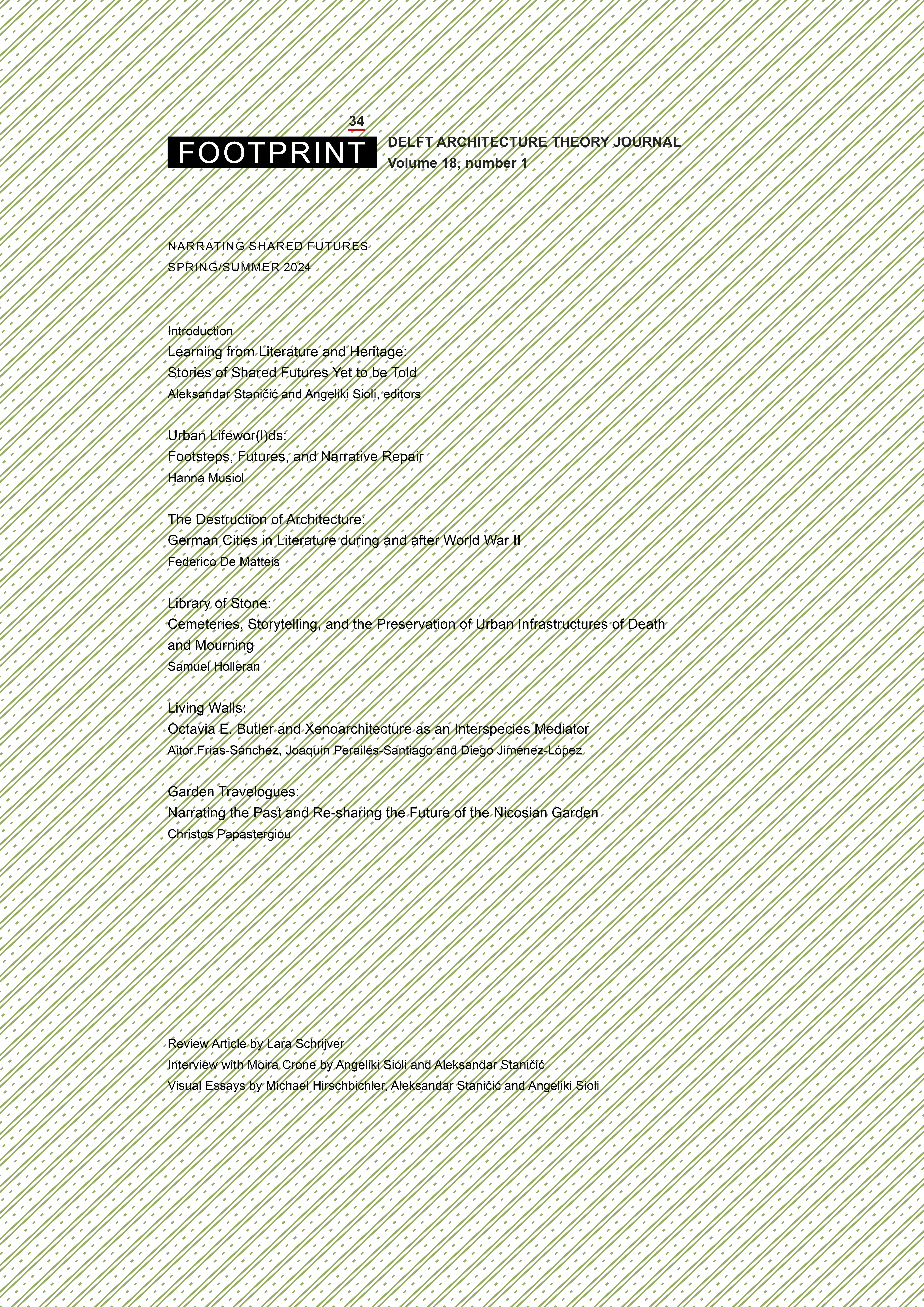
Issue # 34 | Narrating Shared Futures
Vol. 18 No. 1 (2024)Footprint 34, ‘Narrating Shared Futures’, is dedicated to a transdisciplinary encounter between literature and cultural heritage. Namely, in this issue we seek to understand how literature can help us unpack complex meanings of places of heritage, and use that knowledge to imagine, design and produce tolerant and inclusive architectures. We focus our discussion around the three notions that appear in the title of the issue – ‘narrating’, ‘shared’ and ‘futures’, investigating how both heritage architecture and literature can offer valuable lessons for imagining better and more inclusive future worlds. Each of the articles featured in this volume contributes to the proposed framing with powerful and global case studies. Put together, they present new ways in which the past, present and future are constantly being made in-the-now through both literary and design techniques.
Issue editors: Aleksandar Staničić and Angeliki Sioli.
-
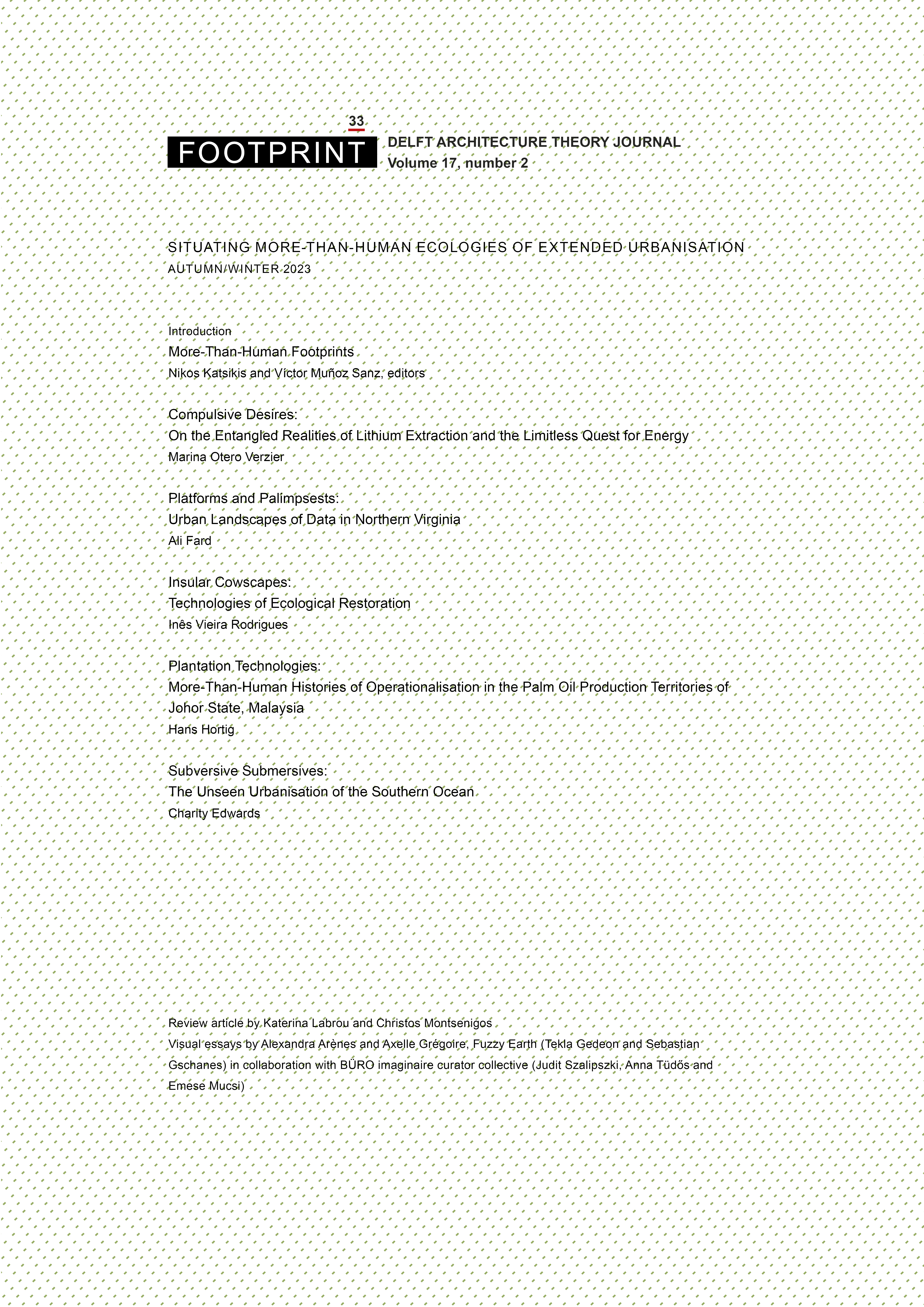
Issue # 33 | Situating More-Than-Human Ecologies of Extended Urbanisation
Vol. 17 No. 2 (2023)Footprint 33 explores techno-natural spatialities and materialities found across operational landscapes of primary production. To the extent that these landscapes are increasingly automated and digitised, production and circulation practices are becoming more capital intensive and even less labour-intensive. While amplifying the precarity of human labour, this process relies on appropriating the work of more-than-human assemblages of machines, plants, animals and microorganisms. Central to the focus of this issue is understanding the way these processes are grounded in specific architectural and landscape configurations. In this way, we also aim to complement the debates on past issues of Footprint, offering an investigation of the impact of technological transformations beyond the concentrated landscapes of human inhabitation.
Issue editors: Nikos Katsikis and Víctor Muñoz Sanz.
-

Issue # 32 | Spring/Summer 2023 | Rethinking the Architecture of Dwelling in the Digital Age
Vol. 17 No. 1 (2023)Footprint 32 looks into the many ways the digital turn has impacted the architecture of dwelling. The issue originates from a simple observation: After the digital turn, the house as a paradigm for the discipline seemed to have gone missing from architecture debates. Recent theorisations of the digital in architecture have almost exclusively focused on new methods of production and notions of materiality alongside profound changes to the urban and social dimensions of the built environment. The question of dwelling after the digital turn leads to scrutiny of the history of the digitisation of the house and the shifting nature of domesticity, and to an exploration of involved motivations and values, oscillating between a techno-utopianism to a techno-capitalism. While the boundaries between real and virtual realms are blurred, the house and dwelling find a reconceptualisation in ecological and relational terms, thereby dissolving the house as a discrete object or entity. Privacy, autonomy, and physicality are in need of a rebalancing.
Issue editors: Dirk van den Heuvel and Nelson Mota
-
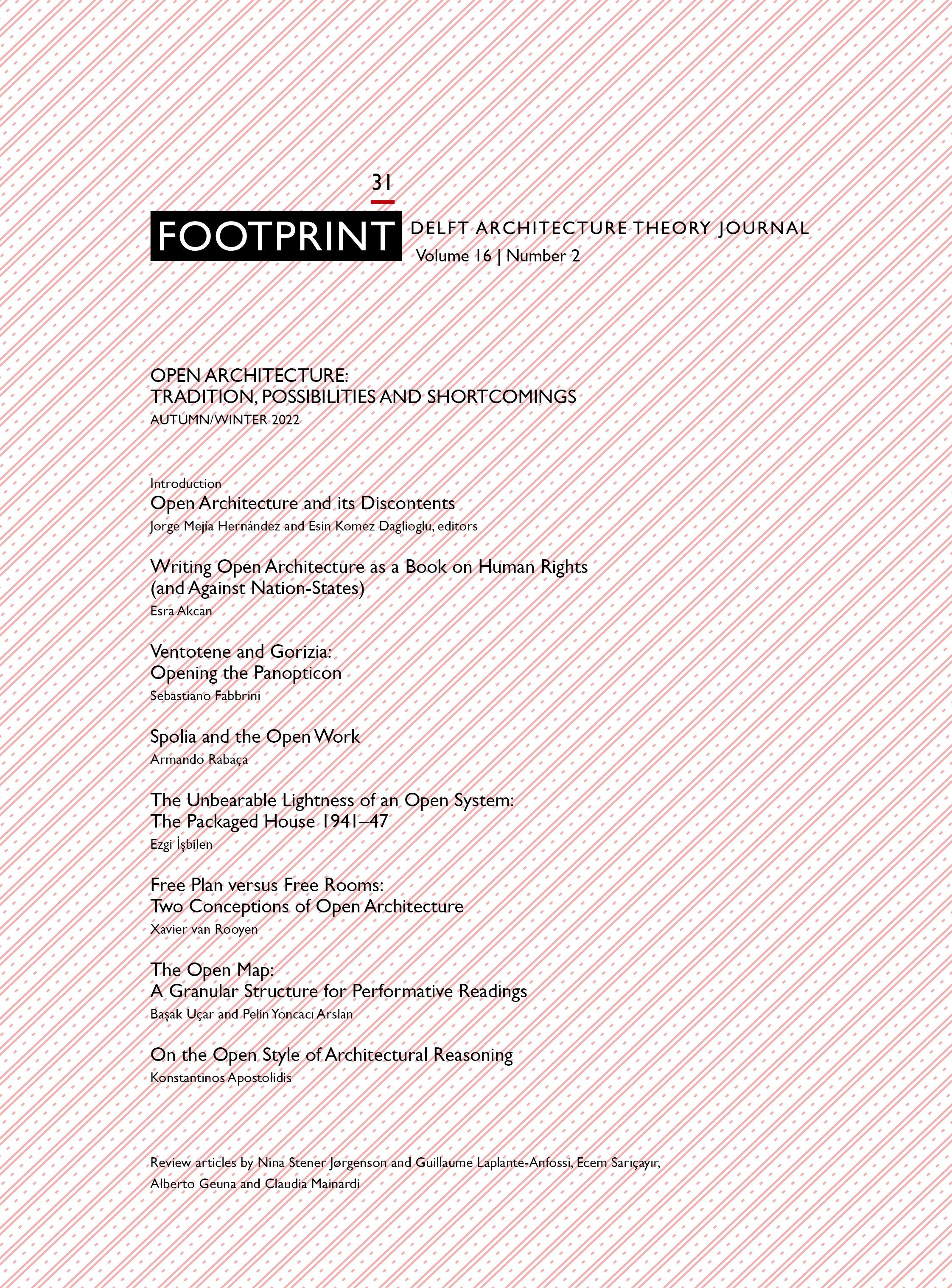
Issue # 31 | Autumn/ Winter 2022 |Open Architecture: Tradition, Possibilities and Shortcomings
Vol. 16 No. 2 (2022)Footprint 31 examines a number of ways in which architecture can be understood as open. Ranging from structural to procedural, and from performative to conceptual forms of openness, the articles collected in the issue elaborate on a diversity of open architectures of the past and present, in political, ideological, semiotic, technological, morphological, representational, and epistemological terms. Review articles provide further illustration by analysing three architectures by Nicolas Schöffer, Frank van Klingeren, and Lacaton and Vassal (with Jacques Hondelatte). The theoretical and methodological advantages and disadvantages of architectural openness identified by all contributors suggest alternative conceptualisations for the concept, and invite further reflection on the effectiveness and efficiency of its use towards the future.
Issue editors: Jorge Mejía Hernández and Esin Komez Daglioglu
-
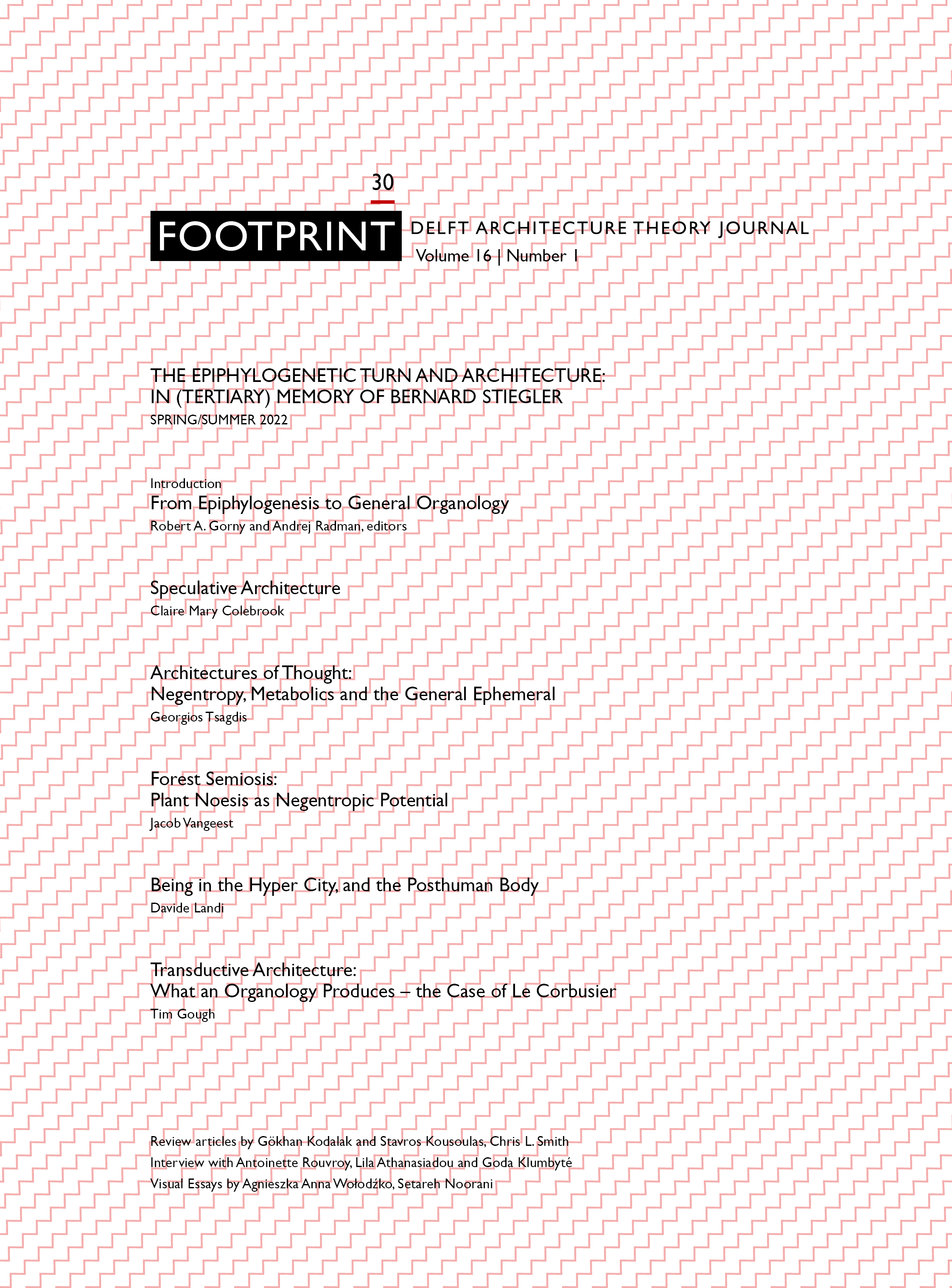
Issue # 30 | Spring/ Summer 2022 |The Epiphylogenetic Turn and Architecture: In (Tertiary) Memory of Bernard Stiegler
Vol. 16 No. 1 (2022)Footprint 30 explores the work of French philosopher of technology Bernard Stiegler (1952–2020) to critically rethink the built environment in terms of a constructed yet emergent existential niche. Foremost concerned with technics, the purchase of Stiegler’s thinking and conceptual apparatus is to be found in the proposition of a novel theoretico-methodological turn towards epiphylogenetic processes. Yet to be embraced by discourses on architectural and cultural technologies, the notion of epiphylogenesis implies a kind of recursive path-dependent co-evolution of living systems with non-living means, especially technics. This sympoietic vision – of how culture-shaping technics and technical ensembles like cities (trans)form us – urges us to rethink how environments re-shape ontogenetic processes. The contributions to the issue call for a radical recasting of the architectural discipline by reconsidering the ‘what’ of technicity as constitutive of a (post)human ‘who’.
Issue editors: Robert A. Gorny and Andrej Radman
-
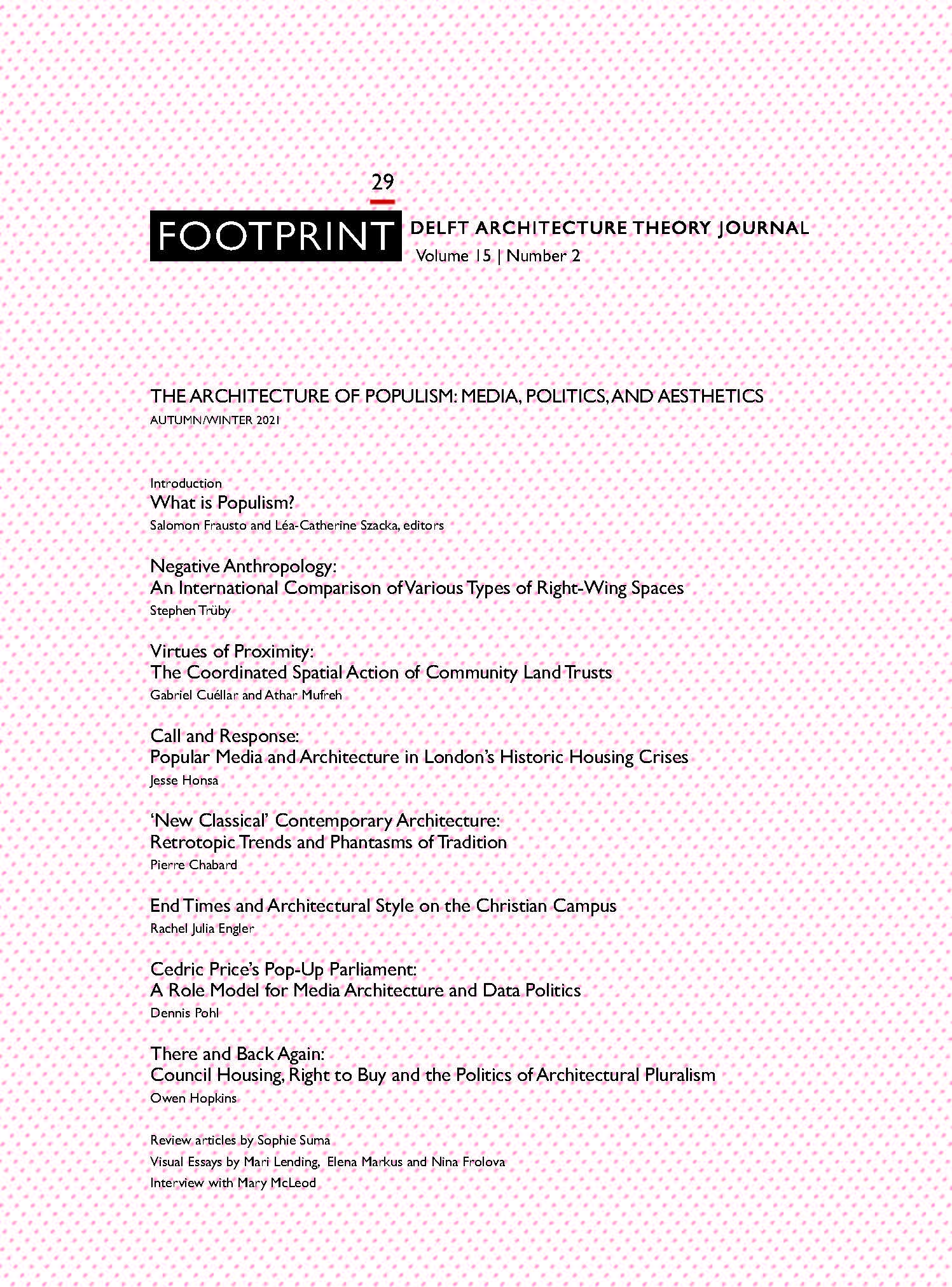
Issue # 29 | Autumn/ Winter 2021 |The Architecture of Populism: Media, Politics and Aesthetics
Vol. 15 No. 2 (2021)This issue of Footprint questions the complex concept of populism, explaining how, in recent debates, it has more and more often been related to architectural issues. Partly based on the analysis of political philosopher and historian Jan-Werner Müller, our understanding of the term reaches to both ends of the political spectrum. Yet rather than simply aiming to provide a clear definition of populism, this issue sheds more light on a debated concept, showing its multi-facetted aspects in relation to space and aesthetics. Through the categories of media, politics and aesthetics, this issue also shows the logical progression between the different pieces included. Acknowledging the complex nature of the word populism is essential for the understanding of the variety of takes included in this issue.
Issue's editors: Salomon Frausto and Léa-Catherine Szacka
-
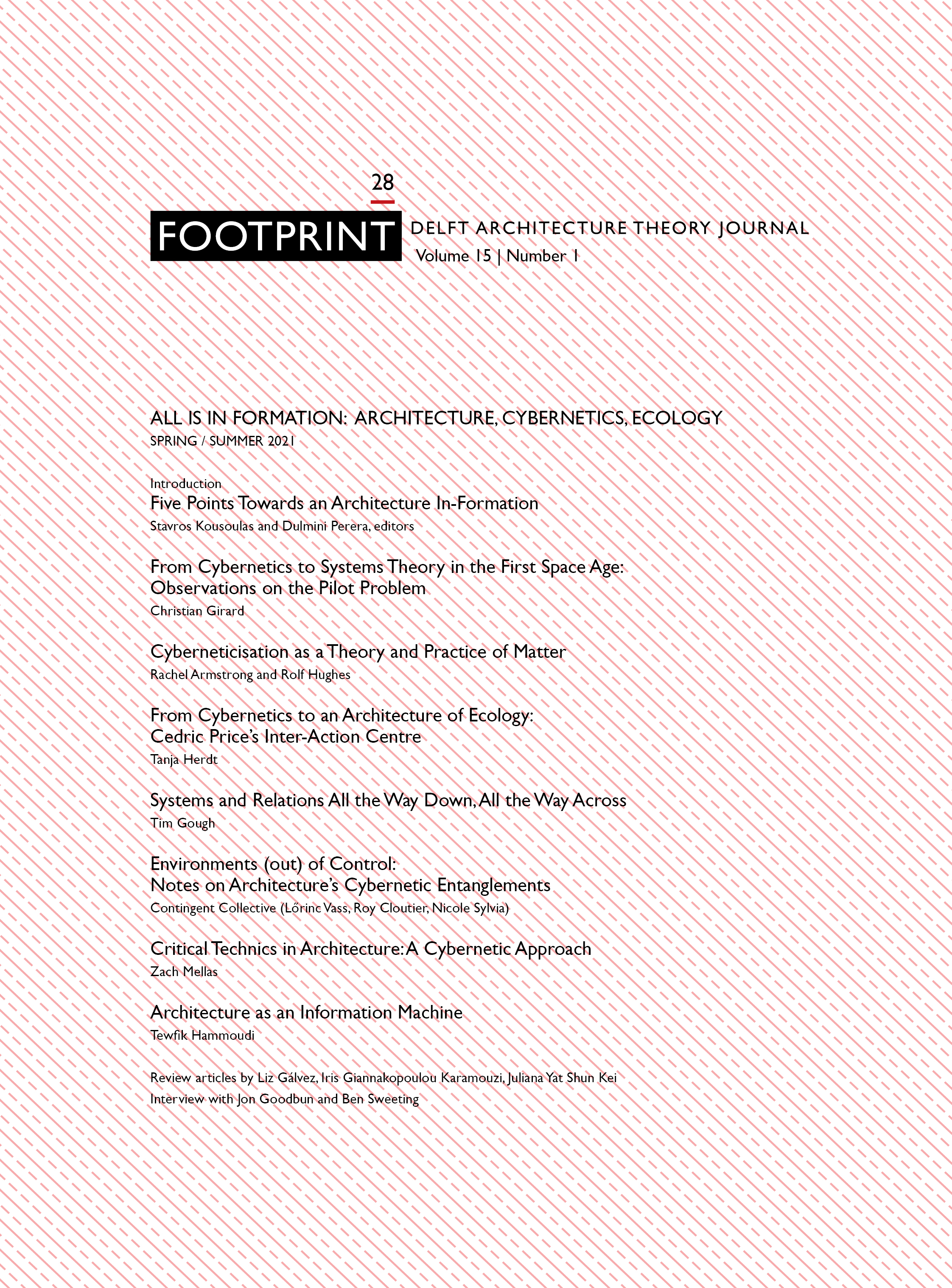
Issue # 28 | Spring/ Summer 2021 | All is in Formation: Architecture, Cybernetics, Ecology
Vol. 15 No. 1 (2021)Footprint #28 examines the relation between cybernetics and architecture by focusing on a problem they both share: the production, consumption and flow of information, or, in other terms, of meaning. Therefore, cyberneticisation can set the foundations for a relational account that examines how signs are communicated and how meaning is produced and experienced within systems. This third-order cybernetics extends beyond the original scope of living organisms and their environments in order to include ecologies of ideas, power, institutions, media and so on. In this sense, cyberneticisation is radically environmental, positing the primacy of relations over fixed terms, binary oppositions and linear logics, making it high time for architectural and urban studies to take into consideration its ground-breaking potentials.
Issue's editors: Stavros Kousoulas and Dulmini Perera
-
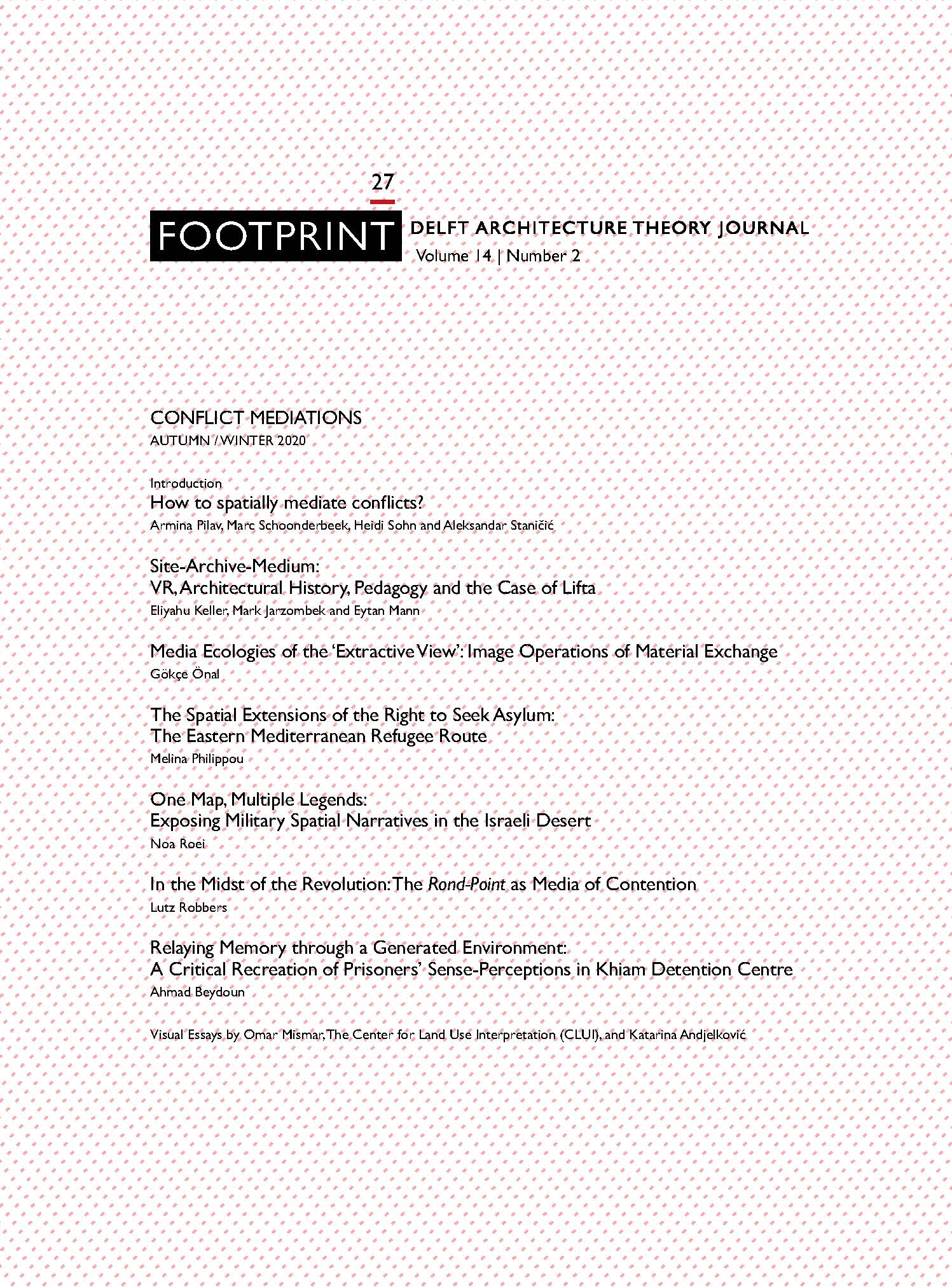
Issue # 27 | Autumn / Winter 2020 | Conflict Mediations
Vol. 14 No. 2 (2020)Various forms of violence and conflict continue to shape our habitats. What historically has been straightforward and even obvious two-way dependency, in recent years took more subtle and covert form due to sophisticated technological advancements in the fields of media, surveillance and armament. Recognising the detrimental effects of these new developments on the way we experience, conceptualise and build our environments, Footprint #27 proposes artistic reflections, cross-media inquiry and counter-tactics as new powerful tools to rethink the complex relationship between conflict, space and mediation. On one hand, the aim of this issue is to deepen and expand theoretical considerations that substantiate investigations of spatial conflicts by making them truly interdisciplinary. On the other, it seeks to empower architects and artists in their pursuit of exposing, critiquing and fighting spatial violence by reclaiming/unlocking the enormous potential of media tools.
Issue's editors: Aleksandar Staničić, Marc Schoonderbeek, Heidi Sohn, Armina Pilav
-

Issue # 26 | Spring / Summer 2020 | The Architecture Competition as Contact Zone: Towards a Historiography of Cross-Cultural Exchanges
Vol. 14 No. 1 (2020)This issue of Footprint follows a double trajectory. On the one hand, it advances an ambition for architecture historiography. The social sciences have long recognised the need for more comprehensive and inclusive methods for writing history. Among them, comparative literature scholar Mary Louise Pratt’s ‘contact zone’ appears as a useful framework for writing new histories of architecture that recognise the many interrelations that characterise the discipline of architecture. On the other hand, and among many possible contact zones, the issue focuses on studying the architecture competition as a contact zone. The resulting collection of articles, review articles and an interview show how, when seen as a contact zone, the architecture competition emerges as fertile ground for the production of disciplinary knowledge, resulting from exchanges between different cultures. Acknowledging the diverse nature of these cultures, together with the recognition of institutions, legislation and other conceptual frameworks as key elements of architecture as contact zone offers fresh theoretical insight, but also poses unexpected communicative challenges.
Issue's editors: Jorge Mejía Hernández and Cathelijne Nuijsink
-
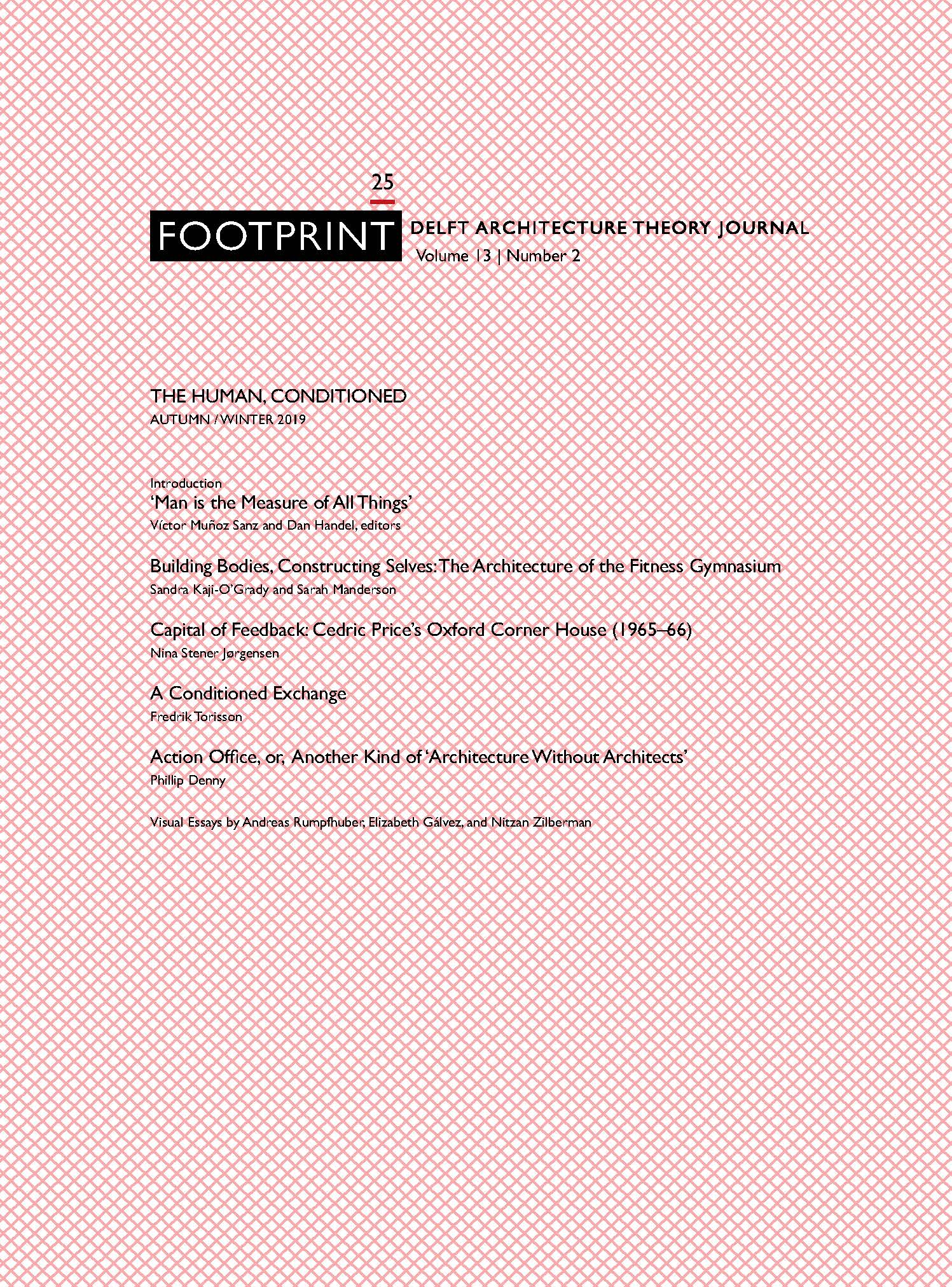
Issue # 25 | Autumn/ Winter 2019 | The Human, Conditioned
Vol. 13 No. 2 (2019)In a moment in which the term Man, and the humanist tradition which followed from it, have been challenged in feminist, queer, poststructuralist, and postcolonial critiques, which questioned its nature, or even pondered if we are actually human, Footprint 25 seeks to add to these perspectives cases of what we call radical conditioning, in which some architectures bypass assumed values of humanism and operate under a wholly different set of values, emanating from industrial and post-industrial economies and its technological developments. Unfolding in the study of histories, architectural types, aesthetics, atmospheres, systems, and users, the research articles and visual essays included in this issue shed light on the many ways architects, advertently or inadvertently, coalesce with forces intending to condition humans. Ultimately, this issue questions how these spaces, in which humans and their artifacts interact in unprecedented ways, could provide architecture with the timely opportunity to challenge our anticipated redundancy, and reconsider its own humanism in order to charge it with new meanings.
Issue editors: Víctor Muñoz Sanz and Dan Handel
-
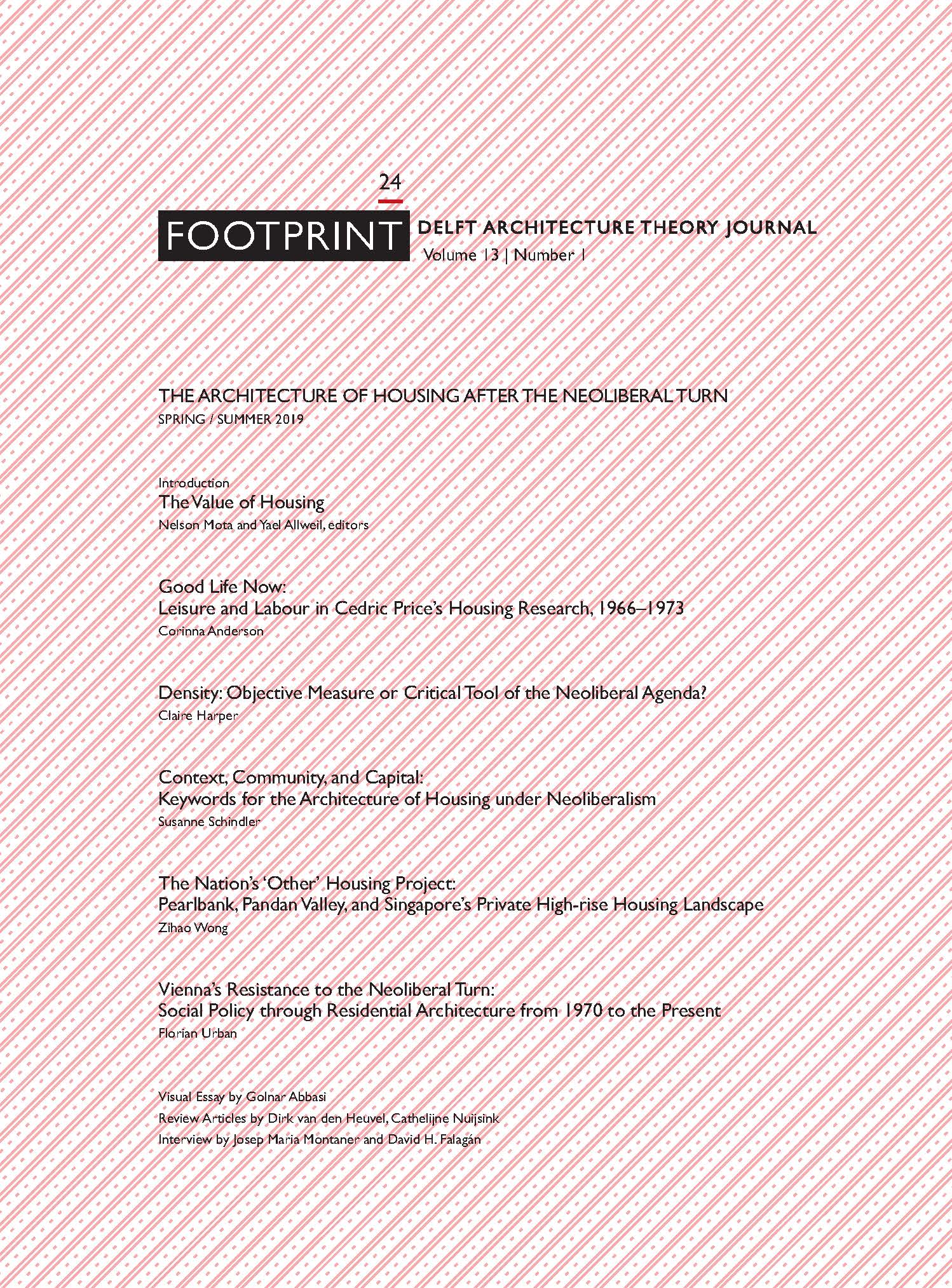
Issue # 24 | Spring / Summer 2019 | The Architecture of Housing after the Neoliberal Turn
Vol. 13 No. 1 (2019)Footprint 24 brings together housing-as-design with housing-as-policy and housing-as-market to discuss what is, today, the value of housing. It discusses how the architecture of housing plays a role in changing behavioural norms and models of subjectivation promoted by the neoliberal ideological agenda. The contributions included in this issue examine different ways of addressing the production of housing either as a social right or a commodity, or both combined. Reviewing cases from North America, Europe and Asia, they discuss the extent to which the social and economic agendas of the public sector and the market determine the architecture of housing. The background of the discussion is defined by a deadlock: the architectural discourse calls upon the state to re-provide housing and solve the crisis, while the neoliberal state is not interested in commissioning housing. Against this background, this issue examines how the architecture discipline can engage in new ways of responding to the neoliberal state of affairs, examining the entwined relation between ‘architecture’ as a cultural product and ‘housing’ as a socioeconomic need.
Issue editors: Nelson Mota and Yael Allweil
-
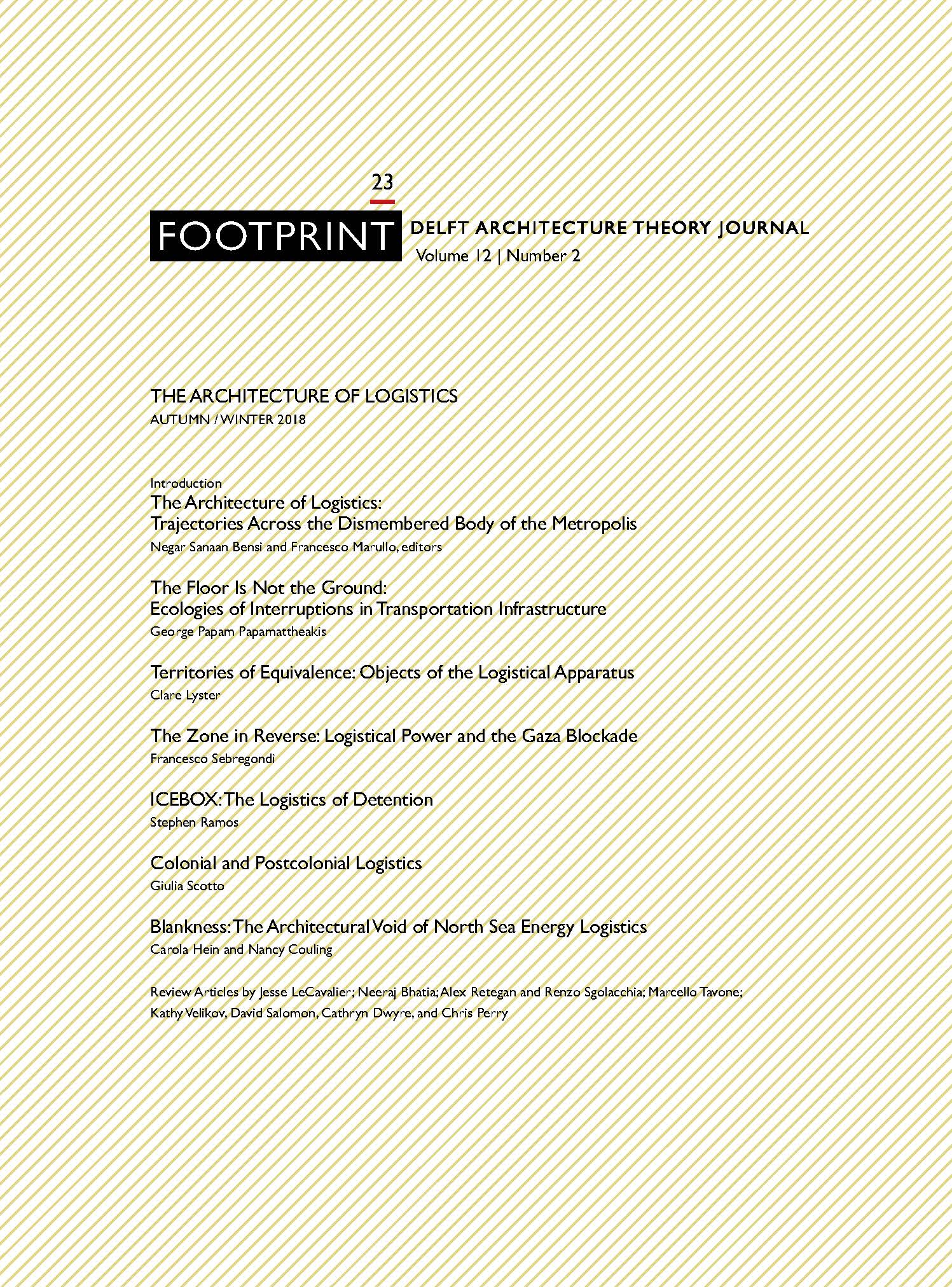
Issue # 23 | Autumn / Winter 2018 | The Architecture of Logistics
The ambition of Footprint 23 is to provide a critical survey of the architecture of logistics, unfolding the multivalences of its apparatus, dissecting its buildings and spaces, its technologies and labour relations, its historical evolutions as well as its future projections. Gathering academic papers and visual essays from researchers and emerging scholars in the field, the issue follows three main directions of inquiry.
The first trajectory attempts to define what logistics is and how it operates, focusing on the inherent ambivalence of its apparatus, able to cope with different scales and various temporal dimensions – from barcodes and gadgets to global routes and territorial infrastructures – constituting both a physical and abstract framework supporting, measuring and quantifying movements and actions, thoughts and desires. The second trajectory investigates the way logistics penetrates our existences, not simply by affecting how we live and work but the way in which it provides the very possibility of life as such, or, in other words, how logistics is inherently political. The third trajectory tackles the past, present and future of logistics, considered as the most crucial apparatus determining the human impact on the earth, controlling the distribution and organisation of organisms and ecosystems, triggering new and more violent forms of colonisation and exploitation.
This issue of Footprint does not seek definitive statements or hypothetic solutions for the monstrous nature of logistics. On the opposite, it aims at unfolding its inner contradictions to propose new possibilities of exploration for an architecture and its project.
Issue's editors: Negar Sanaan Bensi and Francesco Marullo
-
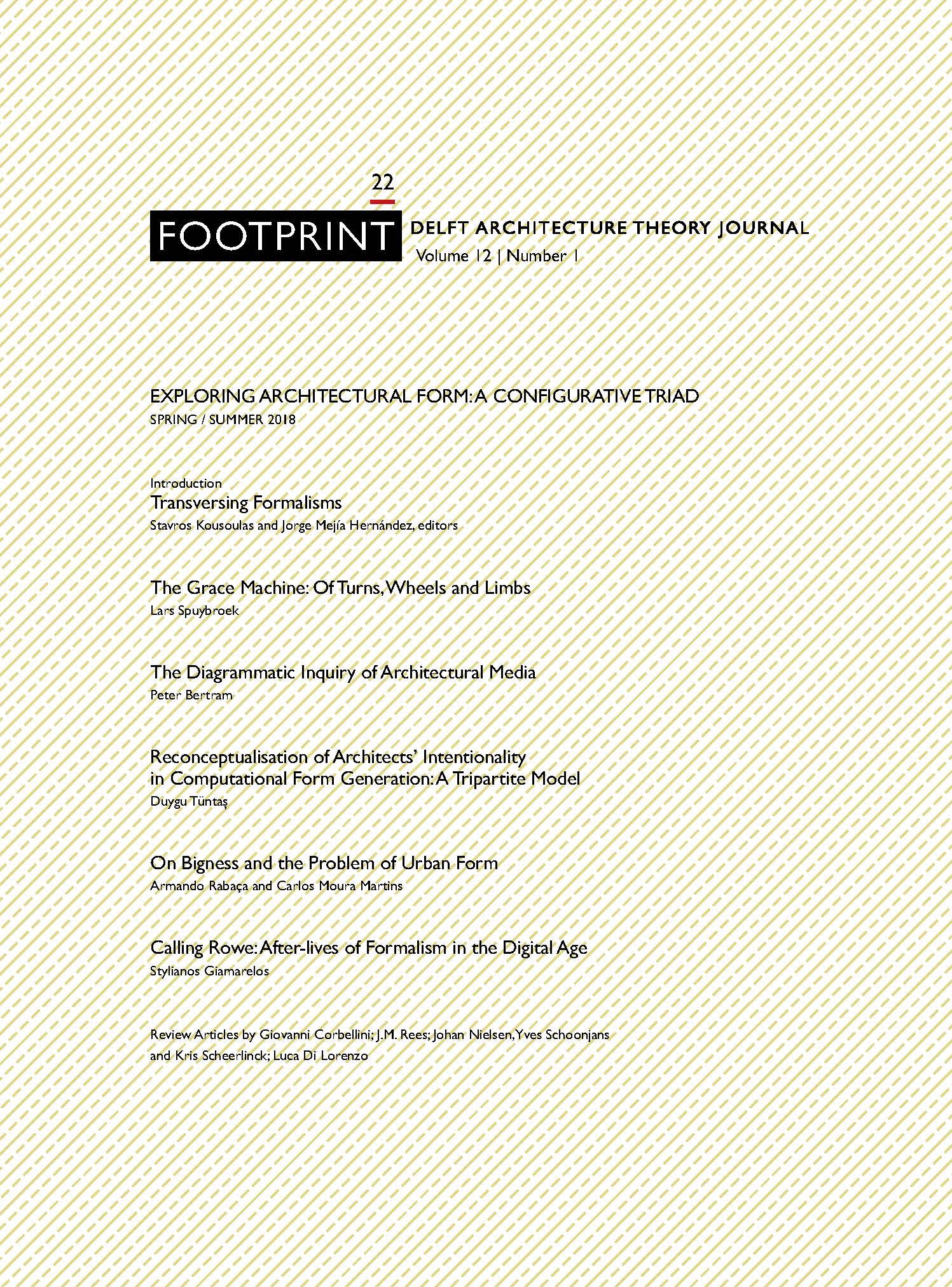
Issue # 22 | Spring / Summer 2018 | Exploring Architectural Form: A Configurative Triad
This issue of Footprint follows a tripartite trajectory regarding formal studies. On the one hand, it includes reflections on the way built form is produced, while, on the other, it gathers studies that examine how architectural form appears in discursive and communicative terms. Finally, it serves as an attractor for multiple inquiries into the different relations that can be established between human actions, understood in the broadest possible terms, and the shape of the built environment. By interrelating these three approaches, the aim is to embrace and braid object-based approaches to form with approaches that examine the reciprocity of formal emergence and studies dealing with in-formation. Emulating Joseph Kosuth’s well-known triptychs, a constant problematisation of architectural form is situated between these three topical interpretations, understood as architecture’s configurative triad. Acting on the threshold of various discursive outlines, the contributions to this issue transverse several kinds of formalisms, highlighting that beyond the limitations of any specific discourse, their heterogeneous assemblage can afford the production of theoretical, methodological and conceptual innovations in the field of contemporary formal studies.
Issue's editors: Stavros Kousoulas and Jorge Mejía Hernández
-
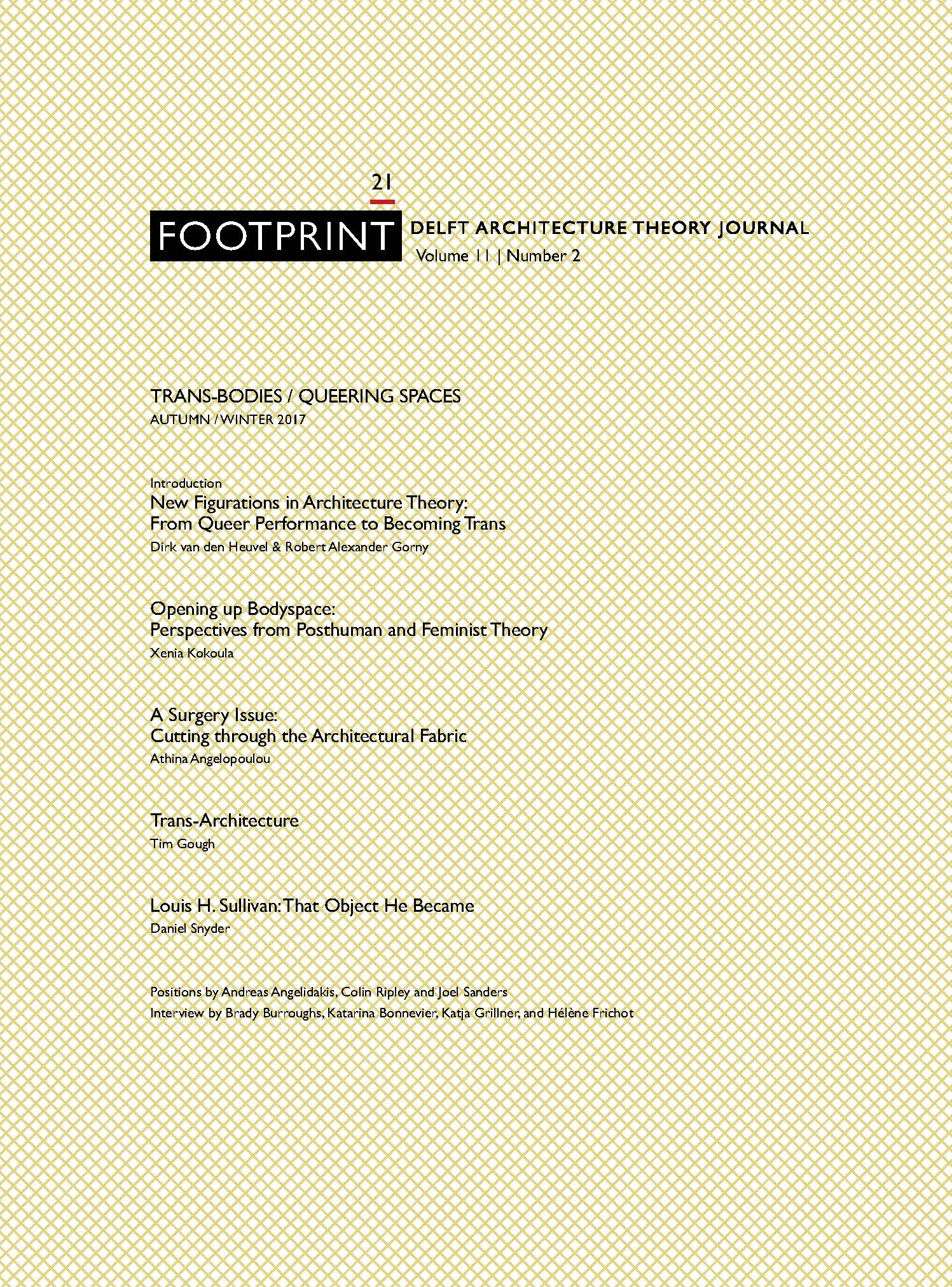
Issue # 21 | Autumn / Winter 2017 | Trans-Bodies / Queering Spaces
This issue of Footprint looks into the latest developments in queer theory and the related, newly emerging field of trans studies, and how they might inform and even reconceptualise architecture. Even though the introduction of queer theory into architecture dates back to the 1990s, there is still fairly little literature available specific to architecture. Most contemporary research into queer and trans theory happens in the fields of cultural studies, literature and the arts and social geography, whereas a cross-disciplinary connection between architecture, urban design and queer theory seems only logical from the point of view that architecture and urban design are instrumental in the formation of social and political identities. Additionally, queer and trans theory offers the possibility of opening up the disciplinary straightjacket of architecture: it engenders a radical reconceptualisation of the architectural discipline and its institutions in that queer and trans theory unsettles any conception of architecture as an embodiment of essentialist categories, be it identities, forms and types, just as it disturbs the mythologies of authorship and autonomy. Concerned with radical inclusiveness, this issue proposes to use ‘queering’ and ‘transing’ as lenses to more generally critique ‘exclusive’ conceptions of architecture, as well as mutually exclusive container concepts of spaces and bodies. What could architecture do, if we would leave behind essentialist approaches? Would it be possible to ‘undo’ the body of architecture and architecture theory and to allow for new figurations of knowledge, to ‘queer’ our understanding of architecture as a field engaged in consistent transformation, the material interface of processes of becoming?
Issue's editors: Robert Gorny and Dirk van den Heuvel
-

Issue # 20 | Spring / Summer 2017 | Analytic Philosophy and Architecture: Approaching Things from the Other Side
This issue of Footprint explores the potential role of analytic philosophy in the context of architecture’s typical affinity with continental philosophy over the past three decades. In the last decades of the twentieth century, philosophy became an almost necessary springboard from which to define a work of architecture. Analytic philosophy took a notable backseat to continental philosophy. With this history in mind, this issue of Footprint sought to open the discussion on what might be offered by the less familiar branches of epistemology and logic that are more prevalent and developed in the analytic tradition.
The papers brought together here are situated in the context of a discipline in transformation that seeks a fundamental approach to its own tools, logic and approaches. In this realm, the approaches of logic and epistemology help to define an alternate means of criticality not subjected to personalities or the specialist knowledge of individual philosophies. Rather the various articles attempt to demonstrate that such difference of background assumptions is a common human habit and that some of the techniques of analytic philosophy may help to leap these chasms. The hope is that this is a start of a larger conversation in architecture theory that has as of yet not begun.
Issue's editors: Karan August and Lara Schrijver
-

Issue # 19 | Autumn / Winter 2016 | Spaces of Conflict
Footprint 19 focuses on the more recent roles of architecture in the contemporary spaces of conflict. Departing from a spatial understanding of geopolitical, climatological and economical conflicts, the various contributions highlight the large scale and phenomenal transitions in the physical world and in society by extrapolating, through examples, the abundance of relations that can be traced between conflict, territory and architecture. Conflict areas often prove to be fertile grounds for innovation and for the emergence of new spatial forms. The issue reports on the state of perpetual global unrest in architecture through a series of articles and case studies that highlight the consequences of conflicts in the places and spaces that we inhabit. In the introduction, these are discussed as an interlinked global reality rather than as isolated incidents. In doing so, the contemporary spaces of conflict are positioned in the context of emerging global trends, conditions, and discourses in the attempt to address their indicative symptoms while reflecting on their underlying causes.
Issue's editors: Marc Schoonderbeek and Malkit Shoshan
-
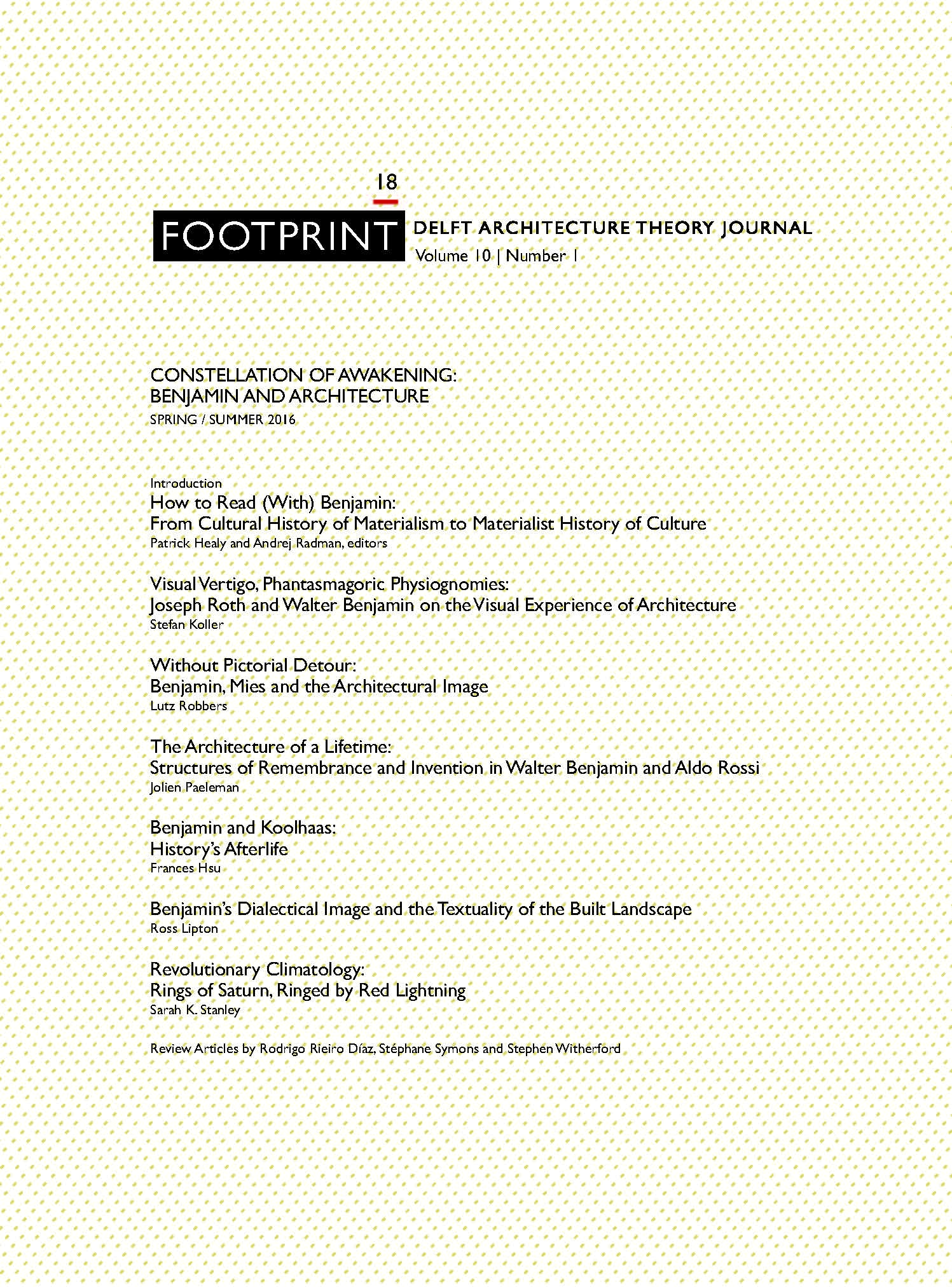
Issue # 18 | Spring / Summer 2016 | Constellation of Awakening: Benjamin and Architecture
In Das Passagen-Werk Benjamin cites a letter from Marx to Ruge, ‘the reform of consciousness consists solely in [...] the awakening of the world from its dream about itself.’ This idea of awakening recurs in Benjamin’s methodological considerations and his many metaphors during the final thirteen years of his life. Benjamin set himself the pedagogical task of awakening ‘the image-making medium within us, raising it to a stereoscopic and dimensional seeing into the depths of historical shadows.’ His ambition was to develop the art of citing without quotation marks, a concept intimately related to that of montage.
The importance of architectural theory for Benjamin is most evident in his last work. From his writings on Berlin childhood, his essay on Moscow and Naples, Benjamin’s interest in urban topography can be seen to develop into a full analysis of the city, by developing a method which he refers to as physiognomic and in which, inspired by contemporary surrealist practise, the method of montage becomes critical for his showing how the ‘now of recognition’ in the image opens the historical to awareness, and constitutes the reality of history. He cites Giedion and sees his own work as engaged in a similar task: ‘just as Giedion teaches us to read off the basic features of today’s architecture in the buildings erected around 1850,’ Benjamin writes, ‘we in turn would recognise today’s forms, in the life and in the apparently secondary lost forms of that epoch.’
It was a matter of immediate concern for Benjamin to examine the secondary, the excluded. By a displacement of the angle of vision a positive element would emerge, something different from that previously signified. History is in the nuance, the dialectical contrast as revealed in Benjamin’s Parisian studies of the expressive character of the earliest industrial architecture, machines, department stores and advertisements. Nevertheless, as is clear from his note of the comment from Max Raphael’s Proudhon, Marx, Picasso, Benjamin reproaches Marx for not having advanced along this way in the full measure of the possibilities of historical materialism.
Issue's editors: Patrick Healy and Andrej Radman
-
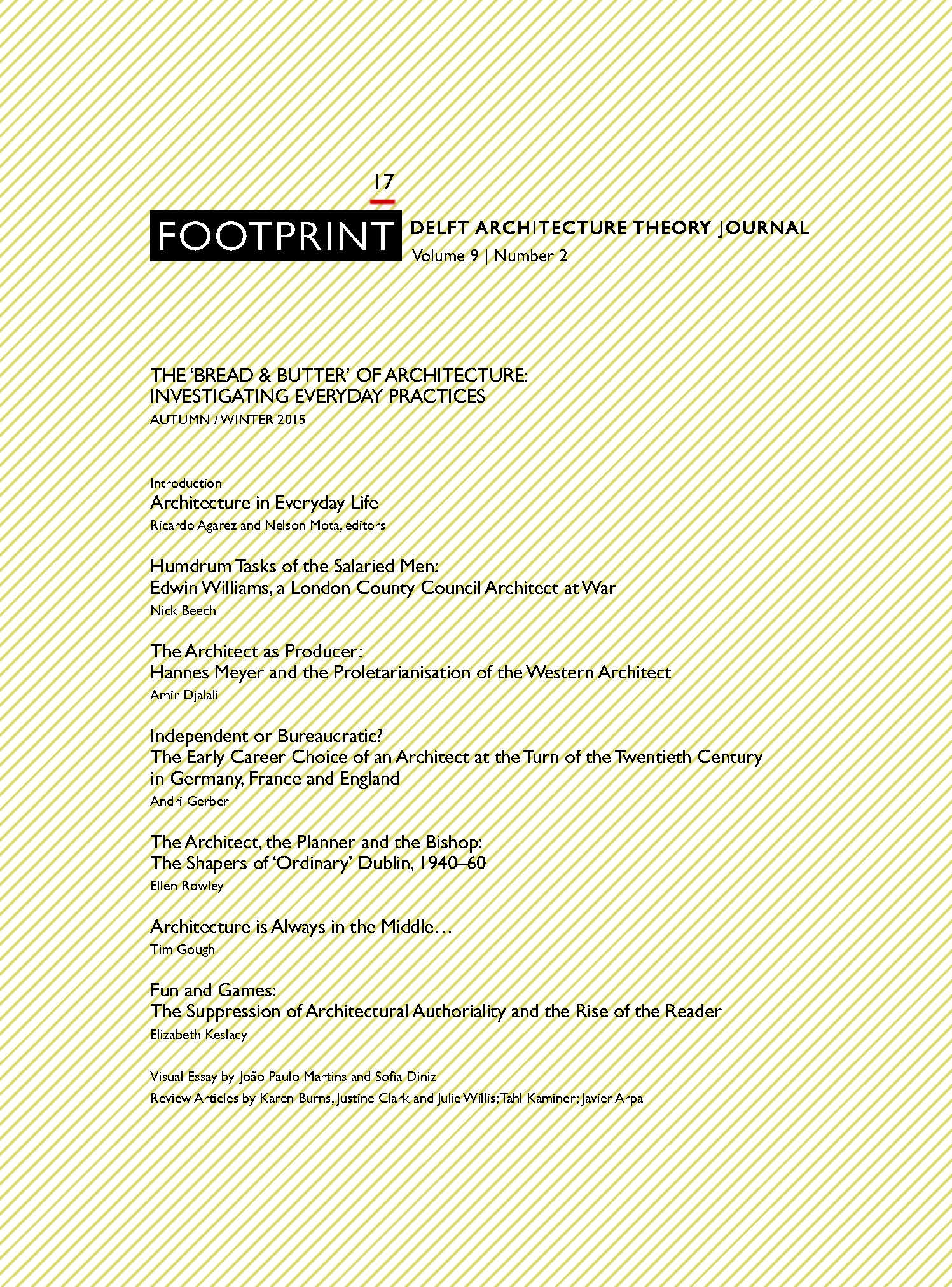
Issue # 17 | Autumn / Winter 2015 | The ‘Bread & Butter’ of Architecture
The canon of western contemporary architecture has overlooked everyday, ‘salaried’ architecture – overwhelming as it may have turned out to be in our built environment – praising instead the solo designer and his ground-breaking work. Since World War I, the social role of the architect (in terms both of his or her place in social hierarchies and of his or her contribution for social betterment) seems to have been primarily tested, and largely consolidated, in ‘departmental architecture’. Yet the work of county, city and ministerial architects, heads of department in welfare commissions, guilds and cooperatives, is seldom discussed as such: its specificity as the product of institutional initiatives and agents, as the outcome of negotiation between individual and collective agendas, remains little explored, even when authors celebrate the many public-designed projects that are part of the canon. On the other hand, commercially driven architecture and the business side of the profession are still anathema for many, despite being essential factors in the discipline’s position in society.
Footprint 17 addresses the architectural production of those who played their part in inconspicuous offices and unexciting departments, and that contribute insights to discuss the place of the architecture of ‘bread & butter’ in architectural history studies and in the politics of architectural design and theory. This issue of Footprint explores intellectual frameworks, didactic practices, research methods and analytical instruments that project the disciplinary focus further than the work of the ‘prime mover’, discussing the relevance of ‘salaried’ architects and institutional agency in shaping the spatial and social practices of the everyday.
Issue's editors: Nelson Mota and Ricardo Agarez
-
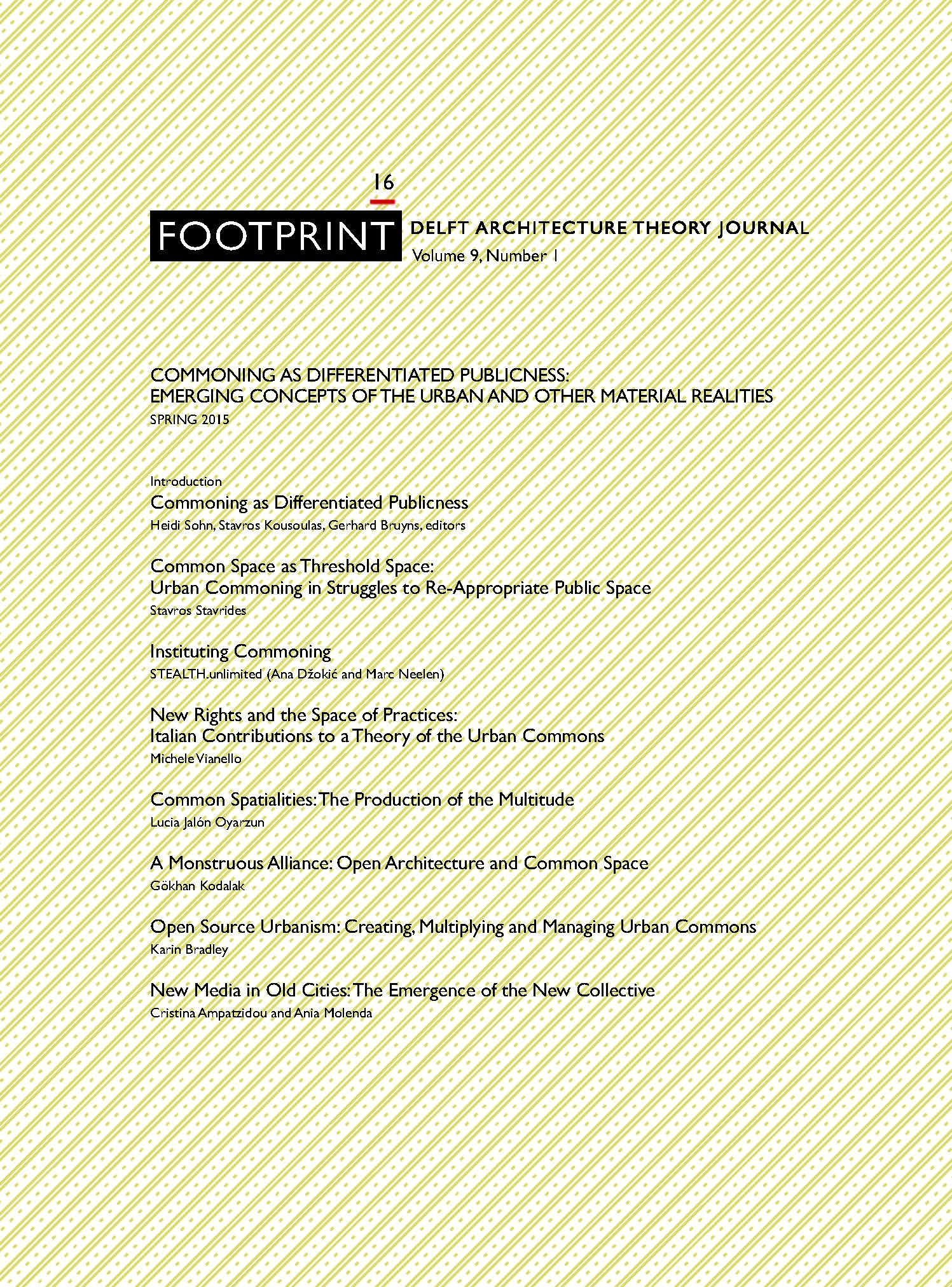
Issue # 16 | Spring 2015 | Commoning as Differentiated Publicness
Contemporary commoning practices are emerging from the failure of a vast array of neoliberal systems and models. Arguably, these practices hold the potential to actualise an in-between niche, which the public and private domains alike have been unable to encompass and express. As such, they invite us to rethink the meaning of the public/private dichotomy. Commoning practices simultaneously respond and give rise to differentiated social and materials forms and relationships, which result in a variety of geopolitical ecologies and new understandings of citizenry.
Issue 16 of Footprint offers an array of diverse insights into contemporary commoning practices. Emanating from different angles of enquiry and theoretical perspectives the articles included here investigate the question of the commons through the re-conceptualisation of different subjectivities. New understandings of the empowering potentials and latent agency of self-organised urban movements, i.e., are approached by means of in-depth analysis and critical assessment. The spectrum of possibilities opened by differentiated political practices and strategies unveil renewed types of legitimacy. Furthermore, critical evaluations of spatial initiatives display emerging socio-spatial bodies, thus questioning the role of autonomy across a spectrum of scales and thresholds of negotiation. Ultimately, the analysis of and speculation on the mechanisms of contemporary commoning re-configure urban reality through the realisation of new materialities.
Issue's editors: Heidi Sohn, Stavros Kousoulas, Gerhard Bruyns
-

Issue # 15 | Autumn 2014 | Dynamics of Data-Driven Design
Digital technology has introduced in the last decades data-driven representational and generative methodologies based on principles such as parametric definition and algorithmic processing. In this context, the 15th Footprint issue examines the development of data-driven techniques such as digital drawing, modelling, and simulation with respect to their relationship to design.
The dynamics between data-driven processes and design, as well as the impact of these processes on artistic and architectural production, is addressed in 5 papers from authors with diverse backgrounds in media studies, art, and architecture. From theoretical explorations discussing cultural swarming techniques and data-driven design representation and materialisation aspects to practical (artistic and architectural) experimentation, this issue indicates the increasing convergence of computational and material systems. Furthermore, it addresses the generation of multiple, emergent results from one and the same computational representation – results that may be realized virtually at the level of design conceptualization, physically at the level of production, and even operationally at the level of artefact or building use where users or the environment contribute to the emergence of multiple physical configurations and outcomes. Data-driven design thereby establishes an unprecedented design to production to operation feedback loop.
Issue's editors: Henriette Bier and Terry Knight
-
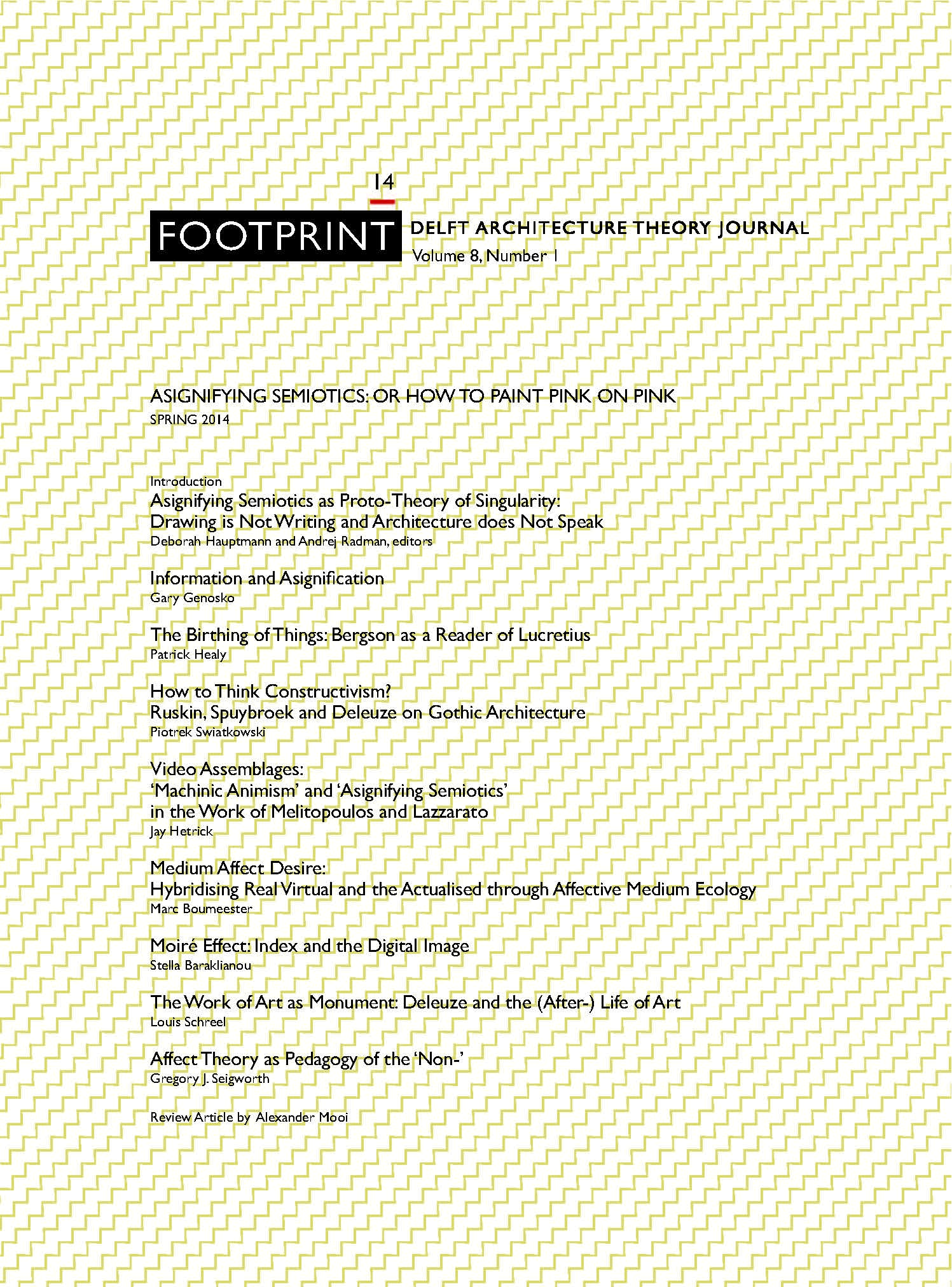
Issue # 14 | Spring 2014 | Asignifying Semiotics: Or How to Paint Pink on Pink
This issue of Footprint examines the notion of asignifying semiotics, which plays a dominant role in contemporary capitalism and becomes indispensable in creating the very conditions for its political critique. Asignifying semiotics is not limited to the semiotics of mathematics, stock indices, money, accounting and computer codes, but includes the semiotics of music, art, architecture, film, dance, and so on. What they have in common is their repudiation of the hegemony of meta-languages. Asignifying signs do not represent or refer to an already constituted dominant reality. Rather, they simulate and pre-produce a reality that is not yet there. Existence is not already a given, it is a stake in the experimental assemblages, be they scientific, political or artistic. Deleuze and Guattari’s principle of asignifying rupture calls for relinquishing the tautological, and hence trivial effort of tracing, in favour of creative mapping. The ten articles in Footprint 14 constitute a cartography that is coextensive with the social field, no longer as mimesis but as poiesis.
Issue's editors: Deborah Hauptmann and Andrej Radman
-
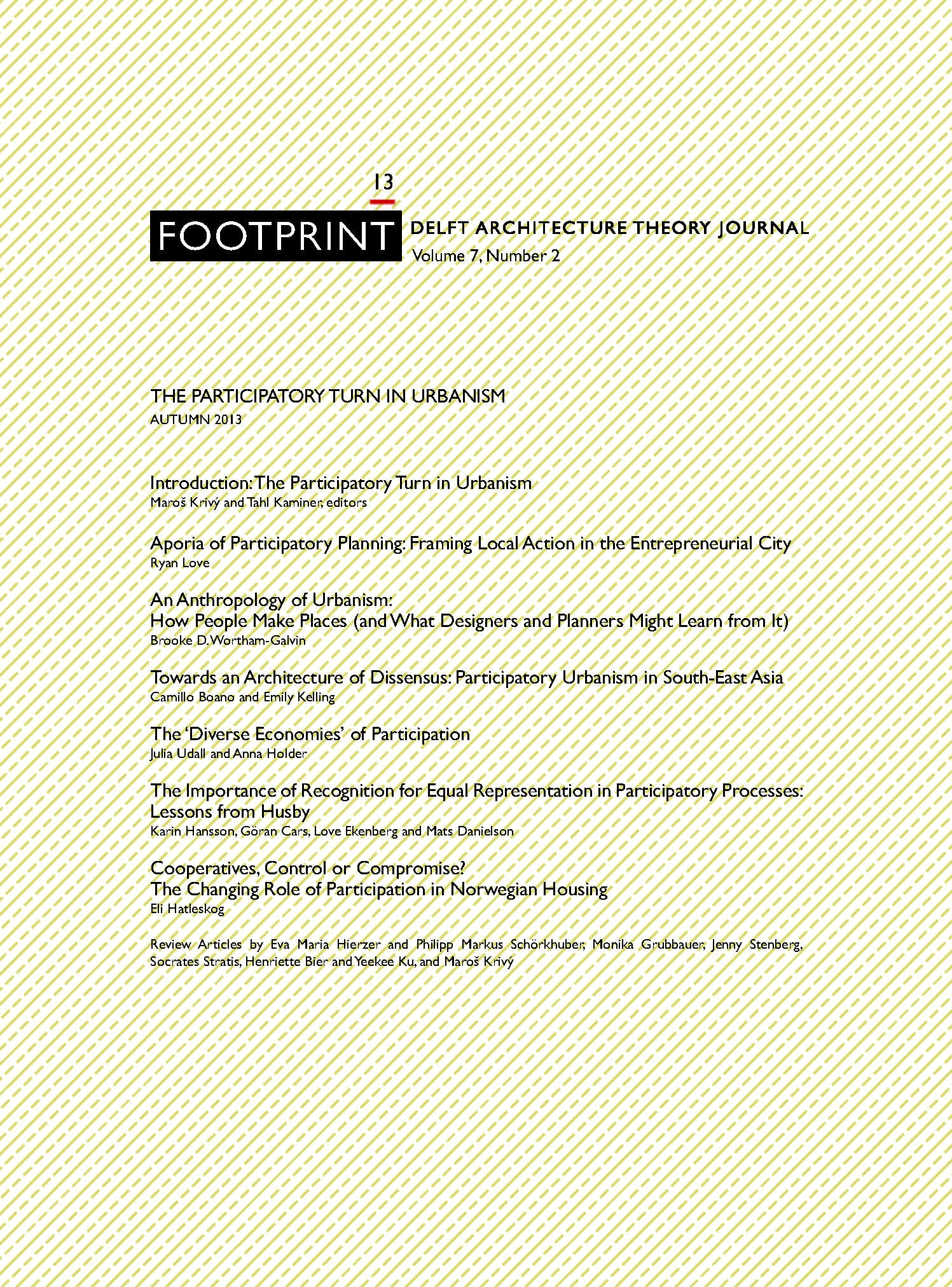
Issue # 13 | Autumn 2013 | The Participatory Turn in Urbanism
This issue of Footprint examines the recent participatory turn in urban planning and urban design. It discusses the co-opting of participatory processes by planning departments, the systematic disregard of inequalities, and the empowering of the market resulting from the ‘anti-statism’ present in many participatory schemes.
What is the relationship between the institutionalisation of participation and the practices of autonomy, self-organisation, and inclusion? When and how does genuine empowerment of collectives take place? Does the demand for the empowerment of local organisations and communities strengthen the market forces at the expense of central government?
This issue attempts to problematise ‘participation’, to call attentions to some of its shortcomings, deficits, and limitations, not in order to necessarily bypass the demand for the democratisation of the urban, but in order to rectify and strengthen it.
Issue's editors: Maroš Krivý and Tahl Kaminer




